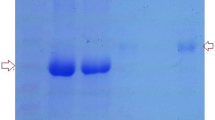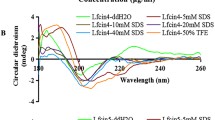Abstract
It has been established that the antimicrobial activity of lactoferrin towards Escherichia coli is enhanced by a direct contact between the protein and the microbial cell and that, in the case of E. coli K-12 strains, an antibacterial activity of lactoferrin unrelated to iron withdrawal is present. Evidence is now reported that lactoferrin binds to surface structures expressed in E. coli K-12 strains grown in either an “excess” or “stress” of iron. Under the experimental conditions used, lactoferrin binding both in the apo and in the iron-saturated form yields a maximum of 1.6 × 105 bound molecules/E. coli K-12 cell; the amount of lactoferrin bound does not depend on the expression of the iron-regulated outer membrane proteins. In contrast, lactoferrin does not bind to E. coli clinical isolates. Apo-lactoferrin (at 500 μ/ml in a chemically defined medium) inhibits the growth of E. coli K-12 strains but not of clinical isolates. These findings suggest that the antibacterial activity of the protein could be associated to its binding to the cell surface.
Similar content being viewed by others
References
Appleyard RK (1954) Segregation of a few lysogenic types during growth of a double lysogenic strain derived from Escherichia coli K-12. Genetics 39:440–448
Arnold RR, Cole MF, McGhee JR (1977) A bactericidal effect for human lactoferrin. Science 197:263–265
Arnold RR, Brewer M, Gauthier J (1980) Bactericidal activity of human lactoferrin: sensitivity of a variety of microorganisms. Infect Immun 28:893–898
Arnold RR, Russel JE, Champion WJ, Brewer M, Gauthier J (1982) Bactericidal activity of human lactoferrin: differentiation from the stasis of iron deprivation. Infect Immun 35:792–799
Artis WM, Patrusky E, Rostinejad F, Duncan LR (1983) Fungistatic mechanism of human transferrin for Rhizopus oryzae and Trichophyton mentagrophytes: alternative to simple iron deprivation. Infect Immun 41:1269–1278
Bortner CA, Miller RD, Arnold RR (1986) Bactericidal effect of lactoferrin on Legionella pneumophila. Infect Immun 51:373–377
Braun V, Hantke K (1974) Biochemistry of bacterial cell envelopes. Annu Rev Biochem 43:89–121
Braun V, Burkhardt R, Schneider R, Zimmerman L (1982) Chromosomal genes for Col V plasmid-determined iron (III)-aerobactin transport in Escherichia coli. J Bacteriol 151:553–559
Brock JH (1985) Transferrins. In: Harrison P (ed) Metalloproteins, Part 2. Metal proteins with non redox roles. Macmillan Press, London, pp 183–262
Broxmeyer HE, Lu L, Bicknell DC, Sledge GW, Williams D, Dippold WG, Hangoc G, McGuire W, Coates T, Cooper S (1985) The interacting role of lactoferrin, transferrin and acidic isoferritins in the regulation of mielopoiesis “in vitro” and “in vivo”. In: Spik G, Montreuil J, Crichton RR, Mazurier J (eds) Proteins of iron storage and transport. Elsevier Science Publishers, Amsterdam, pp 209–220
Bullen JJ, Griffiths E (1987) Iron and infection. John Wiley and Sons, Chichester New York Brisbane Toronto Singapore, pp 1–319
Colonna B, Nicoletti M, Visca P, Casalino M, Valenti P, Maimone F (1985) Composite IS 1 elements encoding hydroxamate-mediated iron uptake in FIme plasmids from epidemic Salmonella spp. J Bacteriol 162:307–316
Crosa JH (1984) The relationship of plasmid-mediated iron transport and bacterial virulence. Annu Rev Microbiol 38:69–89
Dalmastri C, Valenti P, Visca P, Vittorioso P, Orsi N (1988) Enhanced antimicrobial activity of lactoferrin by binding to the bacterial surface. Microbiologica 11:225–230
Ellison RT III, Giehl TJ, LaForce FM (1988) Damage of the outer membrane of enteric Gram-negative bacteria by lactoferrin and transferrin. Infect Immun 56:2774–2781
Guterman SK (1973) Colicin B: mode of action and inhibition by enterochelin. J Bacteriol 114:1217–1224
Hollifield WC, Neilands JB (1978) Ferric enterobactin transport system in Escherichia coli K-12. Extraction, assay and specificity of the outer membrane receptor. Biochemistry 17:1922–1928
Lemberg R, Barret J (1978) Cytochromes. Academic Press, London, pp 1–90
Neilands JB (1982) Microbial envelope proteins related to iron. Annu Rev Microbiol 36:285–309
Nicoletti M, Superti F, Conti C, Calconi A, Zagaglia C (1988) Virulence factors of lactose negative Escherichia coli strains isolated from children with diarrhea in Somalia. J Clin Microbiol 26:524–529
Pedersen K (1980) Electrostatic interaction chromatography; a method for assaying the surface charges of bacteria. FEMS Microbiol Lett 12:365–367
Pugsley AP, Reeves P (1976) Characterization of group B colicin-resistant mutants of Escherichia coli K-12: colicin resistance and the role of enterochelin. J Bacteriol 127:218–228
Redhead K, Hill T, Chart H (1987) Interaction of lactoferrin and transferrins with the outer membrane of Bordetella pertussis. J Gen Microbiol 133:891–898
Simonson C, Brener D, De Voe IW (1982) Expression of a high affinity mechanism for acquisition of transferrin iron by Neisseria meningitidis. Infect Immun 36:107–113
Valenti P, Antonini G, Rossi Fanelli MR, Orsi N, Antonini E (1982) Antibacterial activity of matrix-bound ovotransferrin. Antimicrob Agents Chemother 21:840–841
Valenti P, Visca P, Antonini G, Orsi N (1985) Le transferrine quali fattori umorali ad attivita' antimicrobica: studi sul loro meccanismo d'azione. Ligand Quarterly 4:103–114
Valenti P, Visca P, Nicoletti M, Antonini G, Orsi N (1985) Synthesis of siderophores by E. coli strains in the presence of lactoferrin-Zn. In: Spik G, Montreuil J, Crichton RR, Mazurier J (eds) Proteins of iron storage and transport. Elsevier Science, Amsterdam, pp 245–249
Valenti P, Visca P, Antonini G, Orsi N (1986) Interaction between lactoferrin and ovotransferrin and Candida cells. FEMS Microbiol Lett 10:77–79
Valenti P, Visca P, Antonini G, Orsi N, Antonini E (1987) The effect of saturation with Zn(II) and other metal ions on the antibacterial activity of ovotransferrin. Med Microbiol Immunol 176:123–130
Weinberg ED (1984) Iron withholding: a defense against infection and neoplasia. Physiol Rev 64:65–102
Williams PH, Carbonetti NH (1986) Iron, siderophores and the pursuit of virulence: independence of the aerobactin and enterochelin iron uptake system in Escherichia coli. Infect Immun 51:942–947
Wood JN (1984) Immunofluorescence and immunoperoxidase screening of hybridomas. In: Walker JM (ed) Methods in molecular biology, vol 1: Proteins. Humana Press, Clifton, pp 271–278
Author information
Authors and Affiliations
Rights and permissions
About this article
Cite this article
Visca, P., Dalmastri, C., Verzili, D. et al. Interaction of lactoferrin with Escherichia coli cells and correlation with antibacterial activity. Med Microbiol Immunol 179, 323–333 (1990). https://doi.org/10.1007/BF00189610
Received:
Issue Date:
DOI: https://doi.org/10.1007/BF00189610




